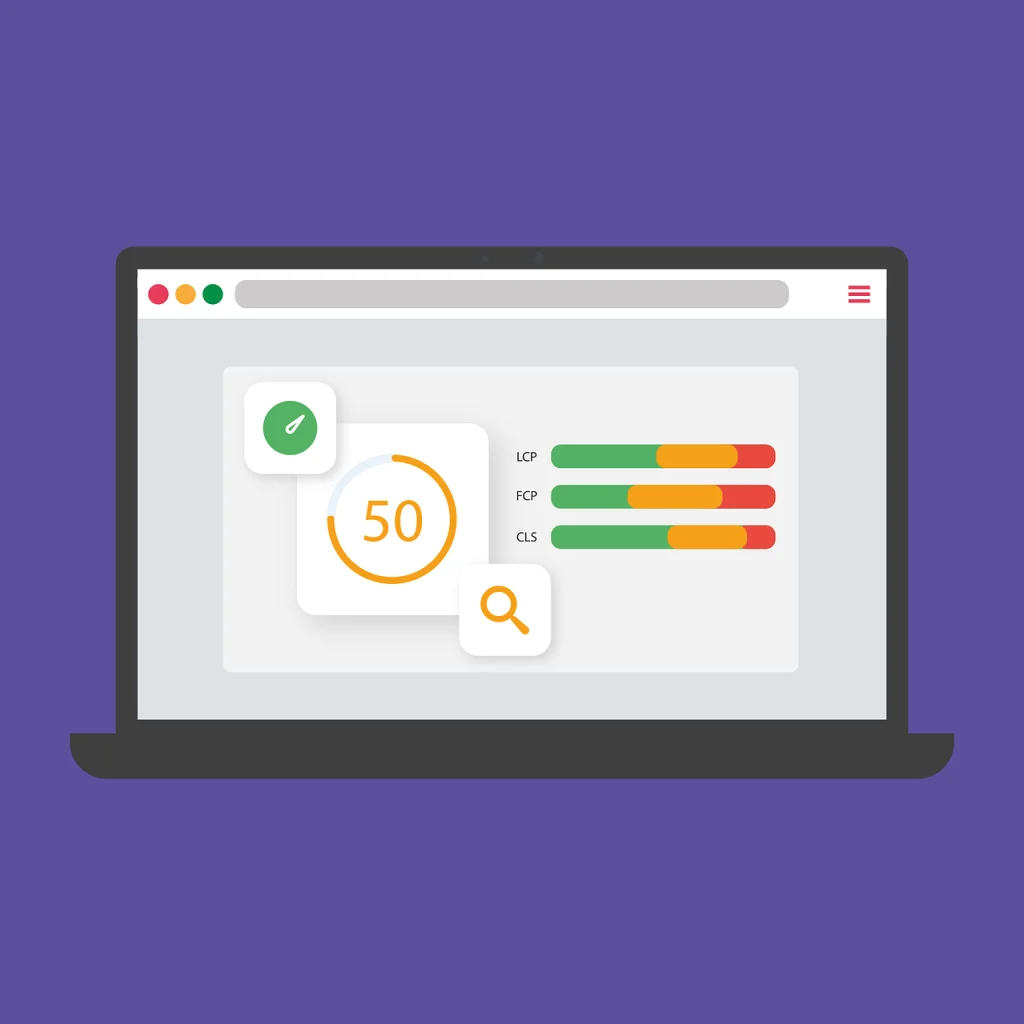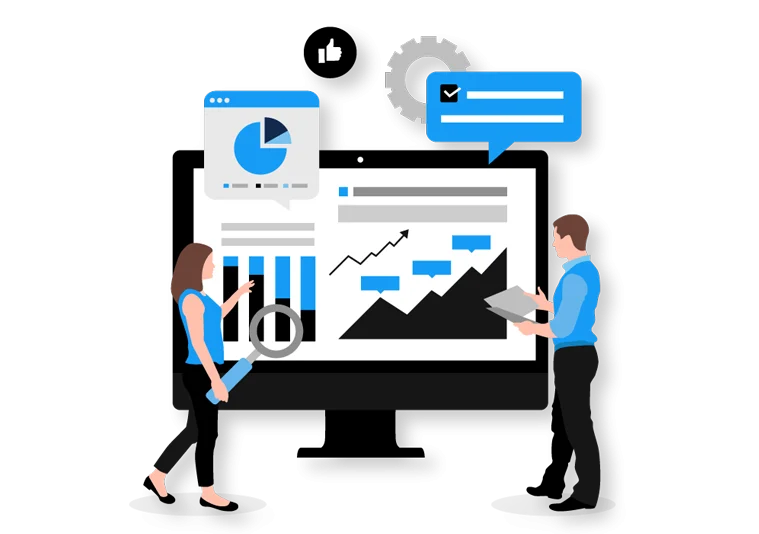
REVENUE DRIVEN FOR OUR CLIENTS
$500 million and counting- Home
- Who We Help
- Industries
- SaaS
- Server Response Time: Slow servers delay loading. Optimizing server configurations can reduce the response time so that pages load swiftly.
- Browser Caching: Repeated requests affect page speed. Enabling browser caching will allow the storage of static files locally, allowing faster page loads for returning users.
- Content Delivery Network (CDN): Used to store site content in various data centers globally. If one content delivery network fails, others take over to deliver content from a closer server, reduce latency, and increase page speed.
- Image Optimization: While large image files lag the page speed, compressing and optimizing images helps web pages load quickly.
- File Size: Heavy HTML, CSS, and JavaScript files slow down the pages. Compressing these files can significantly help pages load faster.
- HTTP Requests: All files require an HTTP request. Combining or eliminating unnecessary files can reduce HTTP response time and speed up the page.
- Web Hosting: Shared or low-quality hosting affects the page speed during high traffic. Choosing a high-performance web host can ensure that pages load consistently.
- Embedded Media: Media files like widgets and videos can slow down the page speed. Lightweight media is a great alternative to help pages load faster.
- Code Structure and Quality: Redundant code, unnecessary inline styles, and extra plugins affect the page speed. Keep codes lean and organized for faster speed.
- Redirects: Excessive redirects involve additional HTTP requests, which reduce page speed and lag the website. Limit redirects for improved page speed and a higher ranking factor.
- Render-Blocking Resources: Scripts and stylesheets can obstruct the rendering of a page and reduce the loading speed. Inline critical CSS and asynchronous loading for scripts can address log and boost page speed.
- First Contentful Paint (FCP) measures the time it takes to display the first content on a webpage.
- Largest Contentful Paint (LCP) is one of the core web vitals for measuring the load time of a page’s most significant content element.
- Cumulative Layout Shift (CLS) quantifies unexpected layout shifts and examines a page’s visual stability throughout the loading process.
- Time to First Byte (TTFB) measures the server response time to a web browser’s request for a page and the load time of the first data byte.
- Fully Loaded Time (FLT) is the time it takes for a page, including scripts, CSS files, and images, to fully display its content in a user’s browser.
- First Input Delay (FID) measures a browser’s time to respond to the user’s initial interaction. A low FID score is an SEO ranking factor, indicating that the page is highly responsive and offers a good user experience.
-
Enhanced User Experience
-
Higher SEO Rankings
-
Increased Conversions
-
Optimized for Mobile Devices
- Average speed index – 3 seconds or less
- Average page weight – Within 500kb
- Average request count – 50 or less
- Average timeframe for the first byte: within 1.5 seconds
- LCP – Under 2.5 seconds
- Reduce the size of the files
- Decrease the time necessary for parsing scripts
- Resolve issues LCP
- Improve server response times
- Enhance content loading times
- Align your business goals with TTFB lab metrics.
- Install and configure a local DNS cache
- Deactivate unnecessary plugins
- Use PHP FastCGI Process Manager to improve PHP’s performance
- Deploy caching if your site uses a content management system (CMS)
- Use database tables for data storage and optimize data queries
- Optimize web fonts and compress images and videos
- Monitor server performance and install updates
- Clean the media library for unnecessary images
- Use plugins like EWWW Optimizer or WP Smush Plugin to reduce the image size
- Use the lazy loading technique to utilize the resources smartly and delay server requests
- Install the WP Asset Cleanup Plugin to detect and remove unnecessary plugins
- Remove unnecessary codes, minify or combine CSS and JavaScript files
- Identify third-party integrations and minimize external scripts
- Use the right redirect type (301 redirects, 302 redirects, or Meta Refresh)
- Test redirects using browser extensions like Redirect Path
- Verify redirects on the Screaming Frog SEO Spider tool
- Check for redirect loops and configure the HTTPS settings
- Use the Quick Redirect Plugin for WordPress to manage bulk redirects
- Utilize Redirectinator for spreadsheet monitoring
How Important is Page Speed for SEO in 2025

Imagine you want to order a book from an online store. You stumble on a website with all the books you want to buy in stock and on sale. You feel it’s your lucky day and rush to order. But suddenly you feel stuck. Despite refreshing it several times, the website just won’t load.
Your patience starts to dip as you wait. Finally, feeling dejected, you hit the back button to check other websites. It is a common scenario for online businesses that lose potential buyers due to slow page speed. But why does page load speed matter for search engine optimization, and what can be done to reduce the page load time? Let’s explore the key essentials!
What is Page Speed?
Page speed describes how fast a web page loads and becomes available to the user. Developers often refer to page speed as page load time to determine the time it takes to display the content or how long it takes a web browser to receive the first byte of information from the user’s browser.
Although used interchangeably, the speed at which a web page loads differs from the speed of a website. While page speed suggests the page load time of a particular page, website speed measures the average loading speed of all the pages of a site. A slow-loading website can result in slow pages, increased load time, a negative user experience, and poor search engine rankings. The table below highlights the differences between page speed and website load speed.
Aspect Page Speed Website Load Speed Meaning Load speed of an individual page Average load speed across multiple pages Measurement Calculated as the load time of a single page The calculation considers the average load time across different pages on the website. Scope Focuses on the page speed analysis of one particular page Focuses on the entire site performance and load speed Influencing Elements Scripts, image quality, and multimedia content Hosting speed, individual page performance, and site architecture Impact on User Experience Slow pages with poor loading speed affect user experience and engagement Affects the website’s performance and usability Search Engine Considerations Influences search rankings and web visibility for individual pages Influences site performance and impacts SEO ranking signals Factors Affecting the Page Speed

You cannot resolve a problem without identifying its key factors. Let’s review the main factors that influence the way website pages load.
Core Page Speed Metrics
As for speed testing tools, Google uses PageSpeed Insights (PSI) to measure page load speed and user experience, analyze the website’s performance on a scale of 0 to 100, and give feedback on applicable improvements. Key page speed metrics include:
Each of these metrics is imperative for conducting speed analysis and improving page speed, eliminating slow loading speeds, enhancing user experience with seamless browsing, and reducing bounce rates. Faster site speed leads to satisfied users, increased engagement, and higher ranking on search engine results pages.
Why Page Speed Matters for SEO?

Page load speed is critical to search engine optimization, influencing page load time, user experience, engagement, and rankings. With users’ attention spans decreasing and expectations for instant page loads increasing, page speed is undoubtedly a decisive factor for higher search engine rankings and successful business outcomes.
Here’s why page speed is significant:
Let’s get real, what would you prefer: a website with an instant load time or one that takes forever to load? Of course, the prior one! No one likes a slow loading speed. Whether desktop or mobile search results, it’s a basic human tendency to consider sites with faster load times. 40% of visitors abandon sites if they don’t get access to what they seek in three seconds, increasing bounce rates and a website’s performance. The page load speed should be fast for an impressive user experience and to reduce the bounce rate.
Google is speed-obsessed. In addition to fast page speed and quick server response time, it considers the core web vitals such as LCP, FID, and CLS to determine the ranking factor. Sites that fail to meet the standards of these metrics and deliver a seamless user experience will lose their digital visibility, and their ranking factor will be affected. So, to ensure the website ranks well and generates leads, the developer must adhere to the core web vitals and optimize the site for faster page speed.
A website’s performance can significantly change if the pages load faster. Visitors won’t leave the site feeling disappointed, which in turn reduces the bounce rate and increases traffic. Most importantly, getting the page speed right can be a win-win situation for the visitor and the business. A visitor gains a positive user experience while the company enjoys a lower abandonment rate, thus creating a lasting impression and a scope for revenue generation and user retention.
Studies have shown that mobile users are likelier to have shorter attention spans than desktop users. Understandably, the website must be optimized so that pages load faster and meet users’ expectations. Fast page speed is essential because 90% of users access information from their mobile devices. Businesses looking to increase traffic, build engagement, and double the conversions from mobile sources should focus on speed so that pages load swiftly and users can navigate the pages without interruption.
What is the Ideal Page Speed for SEO?
Page speed is an important ranking factor for Google. If you follow the standard benchmarks, optimized web pages should have the following elements for a good user experience and SEO ranking:
8 Ways to Improve Page Speed

There’s no sugarcoating it – if you want to meet the core web vitals and ensure pages load faster to give users a seamless experience, you must optimize your website. In an era of escalating competition, your SEO should be on point to reach your prospective clients and turn them into loyal customers. A fast, high-performance website will ensure swift page loading and contribute to the ranking factor, but a suboptimal user experience. Below are eight actionable insights on supercharging your page speed and overall website’s performance.
Implement a Content Delivery Network (CDN)
A CDN is a network of servers that provides cached internet content to the user from the closest network location. It distributes your files across multiple servers globally so users from diverse locations can access your website from a server close to them. If you’re considering investing in a CDN for your eCommerce business, work with experienced developers in eCommerce SEO services. They can offer you the best advice and help reduce server overload, ensure faster content delivery and load times, and maintain consistent performance during high-traffic hours.
Minify JavaScript, CSS, and HTML
Minification removes redundant elements like HTML, JavaScript, and CSS that can slow down the page speed and affect the website’s overall functionality. Minifying them can:
Also, with minification, you can remove unnecessary comments and whitespace from code and shorten variables or function names to speed up the pages. Use Google’s PSI tool to identify potential minified elements to boost your site’s speed and improve ranking.
Optimize Server Response Time
Unoptimized web fonts, too many redirects, using uncompressed media files, and unnecessary plugins and programs are some factors that negatively affect the response time. For improved performance:
Enable Browser Caching
A browser cache saves data from frequently accessed online resources to your device. This reduces the first input delay and allows the browser to load pages faster from the cached resources, reducing loading time and improving UX.
Use server configurations like Apache and Nginx for various file types to enable caching. You can also control cache using WordPress plugins, such as W3 Total Cache, LiteSpeed Cache, WP Rocket, and CDNs, like Akamai and AWS CloudFront.
Reduce HTTP Requests
Excessive HTTP requests can decrease the loading speed of your web pages. To reduce HTTP requests:
Simplify Redirects
To simplify redirects:
Compress Image and File Sizes
Today, almost all website images are of high resolution, meaning they will take up more loading time as they consume extra bandwidth. The best solution is to compress images and reduce the file size. You can use image compression tools like Fotor, Smallpdf, TinyPNG, and Photoshop to adjust the sizes without compromising the quality. Also, try the lazy loading technique to delay image loading. Optimize image metadata to improve SEO performance.
Choose the Right Image Format

Smaller image files load faster and optimize the page speed. While selecting the image format, consider factors like the file size, format, image quality, scalability, transparency, and browser support. Use the JPG, WebP, or AVIF format for images with many details. PNG is ideal for logos, graphics, and illustrations when you need sharp edges. However, use SVG if you want scalable icons and logos. Ensure the format you choose is compatible with popular browsers so the quality remains intact.
Conclusion
Page speed today has become a necessary SEO ranking factor. Whether it’s eCommerce, healthcare, education, or local businesses, a fast-loading web page can connect you with prospective buyers and create endless opportunities. However, fighting the speed demon isn’t everyone’s expertise. Fortunately, you have Wytlabs. We are an eCommerce digital marketing agency specializing in a spectrum of services, including eCommerce web design services and eCommerce CRO services. Our in-house developers have mastered creating fast websites and can optimize yours for high speed and performance. Don’t let slow web pages damage your reputation. Make the most of our services to optimize your pages and gain SEO success with a solid UX. Contact us today!
© 2025 WYTLABS (A Brand of Digimagnet INC.) All Right Reserved.
Schedule My 30 Minutes Consultation Call
We use cookies on our site to provide you with the best user experience. We will assume that you are agreeing to our Privacy Policy, if you continue accessing this website.OK, I AgreePrivacy policyGet a Proposal
- Industries
 CLIENT LOGIN
CLIENT LOGIN




 99 South Almaden Boulevard, San Jose, California, 95113
99 South Almaden Boulevard, San Jose, California, 95113 